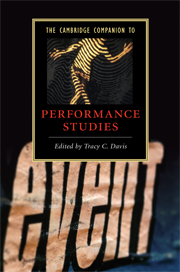Book contents
- Frontmatter
- Introduction: the pirouette, detour, revolution, deflection, deviation, tack, and yaw of the performative turn
- Part I Social polities: history in individuals
- 1 Performance and democracy
- 2 Performance as research: live events and documents
- 3 Movement’s contagion: the kinesthetic impact of performance
- 4 Culture, killings, and criticism in the years of living dangerously: Bali and Baliology
- 5 Universal experience: the city as tourist stage
- 6 Performance and intangible cultural heritage
- Part II Body politics: the individual in history
- Further reading
- Index
5 - Universal experience: the city as tourist stage
from Part I - Social polities: history in individuals
Published online by Cambridge University Press: 28 January 2009
- Frontmatter
- Introduction: the pirouette, detour, revolution, deflection, deviation, tack, and yaw of the performative turn
- Part I Social polities: history in individuals
- 1 Performance and democracy
- 2 Performance as research: live events and documents
- 3 Movement’s contagion: the kinesthetic impact of performance
- 4 Culture, killings, and criticism in the years of living dangerously: Bali and Baliology
- 5 Universal experience: the city as tourist stage
- 6 Performance and intangible cultural heritage
- Part II Body politics: the individual in history
- Further reading
- Index
Summary
My destination is “Universal Experience: Art, Life, and the Tourist Eye,” an exhibition exploring the phenomenon of global tourism, at the Hayward gallery in London's Southbank Centre. The irony is that I can't find the entrance to the Hayward despite the fact that I'm a native Londoner and have been going to the gallery since it opened in 1968, and despite the fact that I'm now a tourist in London (living away from the city for more than twenty years) and so, apparently, hailed by the exhibition's claim to universality. But, then again, I've never been able to find the entrance to the Hayward. Although the building is easily visible from street level, and stairways and walkways provide helpful signage, the actual entrance is obscure and absorbed into an unrelenting concrete landscape, populated chiefly by the usual skateboarders and other (lost?) cultural visitors. The Hayward was designed by the Department of Architecture and Civic Design of the then Greater London Council (GLC) to be a significant cultural contribution in the ongoing renaissance of central London in the postwar period. Notably, some of the department's staff were contributors to the 1960s avant-garde architectural magazine Archigram, and today the Hayward is often heralded as a textbook example of Brutalist architecture championed by, among others, the Archigram Group. The gallery is elevated above street level, a severe mass of concrete among multilevel surfaces, connecting walkways, and oddly positioned circular staircases; as critics often observe, this part of London's Southbank Centre complex more resembles a public car park than a cultural space. And, in this vein, the Hayward is perhaps best captured by the architectural critic Hugh Pearman: “this is uncompromising concrete at its most heavyweight, most muscular, most brutal. But I do like it, for it is a unique record of the period. It is the Mike Tyson of arts buildings.”
- Type
- Chapter
- Information
- The Cambridge Companion to Performance Studies , pp. 76 - 90Publisher: Cambridge University PressPrint publication year: 2008
- 4
- Cited by



